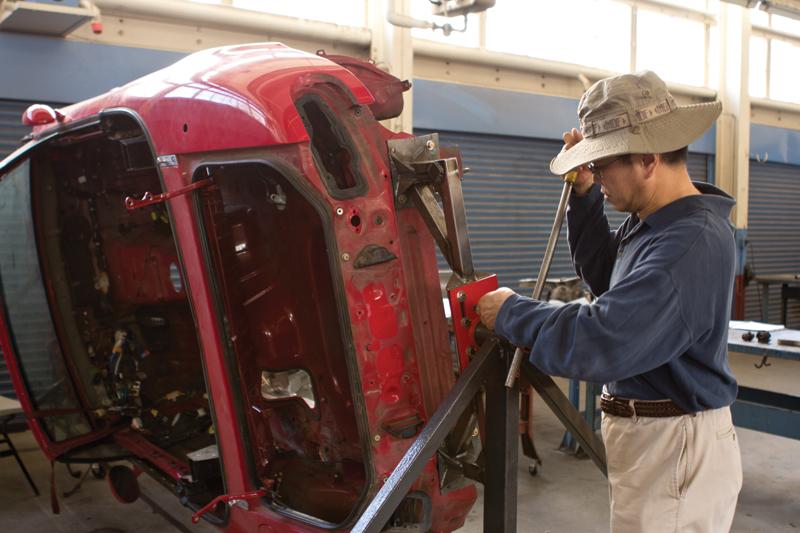
Roe Borunda / The Collegian
Industrial technology instructor Daming Zhang’s IT 127 class went to a junkyard and picked out an old 1989 Mazda MX-5 Miata earlier this year.
In another story, that old Miata would have stayed at the junkyard, ultimately picked to pieces and left to weather the elements.
But Zhang’s class, which is part of the Fresno State Motorsports club, is giving the car a new destiny: to be rebuilt, part-by-part, as a 220-horsepower racecar, and race it in the Sports Car Club of America Autocross.
The task the 12-student class has is to take the small, light, two-seated sports car and resurrect it as a powerful racing machine.
The 1989 Miata was the first model of its kind, and its front-engine, compact design favored speed much like its British and Italian 1960 roadster predecessors such as the Lotus and Alfa Romeo.
Zhang said that the class is designed for students nearing the end of their engineering education.
The class requires students to have general knowledge on how to fix and modify a vehicle, he said.
“The class is a pure activity class,” Zhang said. “Students will have to use their knowledge they have learned to do this project. So, for example, they need to know how to do the welding and they need to know how to use the machine room.”
Since given a new lease on life, the car has been stripped bare, without an engine, wheels or seats. The students are currently reinforcing the build by adding cross-stitching.
The next step for the class is to add a roll cage, then redesign the engine and add a supercharger, bringing the car from 100 to around 220 horsepower.
“Turbo charging a Mazda Miata””that’s something new for everybody,” senior Joaquin Serrano said.
Serrano said this is the first semester he has worked on the vehicle. He said the class has several goals to meet at the end of the year, including putting qualified students behind the wheel.
“The project is to try to get the car back together, get students open to the field of racing and automotive classes and see how it’s done and try to get two seniors this year to get their racing license so they can go out and race this car,” Serrano said.
Serrano believes that In order to get licensed, students will have to go through training courses for safety and do several trial runs in order to get a hang of driving a vehicle built for high-speed racing.
While the class is meant for experienced students, it’s open to anyone willing to learn what goes into vehicle design and repair.
“We invite other students from all different majors, too,” Serrano said. “So you can come here and you can learn how to weld, you can learn how to use machine tools and stuff like that.”
Serrano said he hopes the club will be finished with the car in fall of 2013. He said he plans on graduating next May, but will come back to see the car on the road for the first time.
“It’s a process,” Serrano said. “You can’t really build a car like this, especially with the resources we have, we can’t really put it together as quickly as you think.”
Progress on the vehicle has been steady, Serrano said, but the team has run into some challenges.
Senior Jesse Lee is working on the car as a fabricator. He said that the biggest hurdle for the team has been the lack of proper equipment.
The class is able to buy new car parts using a Instructionally Related Activities grant, Zhang said. However, the money can’t be used on new tools.
“There’s not much usable stuff,” Lee said.
Lee said that many of the tools are so old they can no longer be refitted for new bits.
Zhang said that some of the students have been bringing their own equipment from work and home.
However, the lack of new equipment isn’t deterring the class.
“In the end, you look back on it and (you think), ‘Wow, I did all that with nothing,’ so it’s kind of cool,” Lee said
“It offers the students a really good opportunity to learn what’s all involved in motorsports and racing.”
“The meaning of this project is about the career of the student,” Zhang said. “We want students to learn, and maybe in the future, (use) that as a career.”




